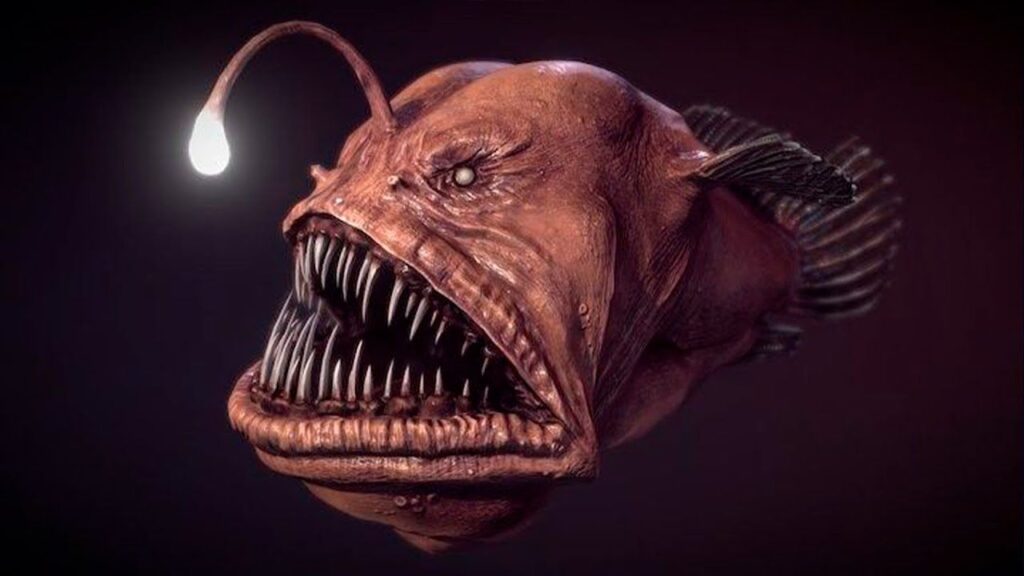Do Angler Fish Attack Humans? Angler fish are deep-sea creatures that rarely encounter humans, and there is no documented evidence of them attacking people.
The deep sea is home to some of the most bizarre and terrifying creatures on our planet, and few are as infamous as the angler fish.
With their grotesque appearance, sharp teeth, and eerie bioluminescent lures, these fish have captured the imagination of people worldwide, often being depicted as monstrous predators of the deep. But amidst the fear and fascination, a common question arises: do angler fish attack humans?
In this blog post, we’ll delve into the myths and realities surrounding these mysterious creatures and uncover the truth about whether they pose any threat to humans.
Contents
What Are Angler Fish?
Overview of Angler Fish
Angler fish belong to the order Lophiiformes, a group that includes a variety of species, all sharing a common trait: a bioluminescent lure protruding from their heads. This lure, known as an esca, is used to attract prey in the dark, murky depths of the ocean.
The angler fish’s appearance is nothing short of nightmarish. With a large, gaping mouth filled with sharp, translucent teeth, and an often disproportionately large head, these fish seem designed to terrify. Yet, their terrifying appearance serves a crucial purpose in their survival.
The angler fish’s body is usually dark and somewhat compressed, helping it blend into the deep-sea environment where light is scarce. [Do Angler Fish Attack Humans?]
Some species are small, only a few inches long, while others can reach up to 3.3 feet in length.
Despite their fearsome appearance, angler fish are relatively small in the grand scheme of marine life, with their menacing features evolved specifically to help them catch prey in an environment where food is scarce.
Habitat and Behavior
Angler fish are primarily found in the deep waters of the Atlantic and Antarctic Oceans, living at depths ranging from 200 to over 2,000 meters.
The environment they inhabit is characterized by near-total darkness, extreme pressure, and frigid temperatures. In such a hostile environment, angler fish have evolved several unique adaptations that allow them to survive and thrive.
One of the most fascinating aspects of angler fish behavior is their method of hunting. Unlike many fish that actively pursue their prey, angler fish are ambush predators. They remain motionless, blending into the dark background, and use their bioluminescent lure to attract prey.
The light emitted by the esca is often pulsating or intermittent, mimicking the movement of small organisms. [Do Angler Fish Attack Humans?]
When an unsuspecting fish or other prey item approaches, the angler fish swiftly snaps its powerful jaws shut, swallowing the prey whole.
This method of predation is highly efficient in the deep sea, where food can be scarce. However, it also means that angler fish are not aggressive hunters in the traditional sense.
They do not chase down or actively seek out large prey, making the idea of them attacking humans highly improbable.

Do Angler Fish Attack Humans?
Myths vs. Reality
The notion that angler fish might attack humans likely stems from their fearsome appearance and the general mystery surrounding deep-sea creatures. [Do Angler Fish Attack Humans?]
In popular culture, angler fish are often portrayed as dangerous predators lurking in the depths, waiting to attack anything that comes near. However, the reality is far less dramatic.
There are no documented cases of angler fish attacking humans. The primary reason for this is simple: the deep-sea habitat of angler fish makes encounters with humans exceedingly rare.
Most humans will never venture to the depths where angler fish reside, and even if they did, it’s unlikely that the fish would view them as prey.
The diet of angler fish consists mainly of smaller fish, crustaceans, and cephalopods. These creatures are easily captured by the angler fish’s ambush strategy, but a human is far too large to be considered potential prey.
Furthermore, angler fish do not have the physical capability to attack or consume something as large as a human.
Their sharp teeth and large mouths are adapted for gripping and swallowing small prey, not for tearing apart larger creatures. [Do Angler Fish Attack Humans?]
Reasons They Don’t Attack Humans
Several factors contribute to the reality that angler fish do not attack humans:
- Deep-Sea Habitat: Angler fish live at depths where humans rarely venture. The extreme environment of the deep sea, characterized by high pressure, cold temperatures, and lack of light, is not conducive to human activity. Submersibles and deep-sea exploration vehicles do occasionally reach these depths, but the chances of encountering an angler fish are slim. Even in the unlikely event of an encounter, the fish would likely be more interested in fleeing than attacking.
- Feeding Behavior: Angler fish are ambush predators that rely on their bioluminescent lure to attract small prey. They do not actively hunt or seek out prey, and their method of predation is not aggressive. They wait patiently for something small enough to be consumed to come close, and then they strike. A human, even in close proximity, would not trigger this predatory response. [Do Angler Fish Attack Humans?]
- Size Discrepancy: The largest angler fish species can reach lengths of up to 3.3 feet, but most are much smaller. Even the largest angler fish are dwarfed by humans, and they simply do not have the physical capability to attack or consume something as large as a person. Their sharp teeth and large mouths are designed for small prey, and they would be ineffective against a human.
- Solitary and Reclusive Nature: Angler fish are solitary creatures that spend most of their lives in isolation. They do not exhibit territorial behavior or aggression toward larger animals. Their primary concern is survival in a challenging environment, and they are unlikely to engage with anything that does not resemble their typical prey.
Are Angler Fish Dangerous?
Understanding the Danger
While angler fish may look dangerous, they pose no real threat to humans. Their appearance, while fearsome, is a result of evolutionary adaptations to their deep-sea environment.
The large teeth, gaping mouths, and bioluminescent lure are all designed to help them capture prey in the dark, cold depths of the ocean. [Do Angler Fish Attack Humans?]
These features are not intended for attacking or defending against larger creatures, and they are not indicative of aggressive behavior.
In fact, the danger posed by angler fish is almost entirely limited to their prey. Small fish, crustaceans, and other deep-sea creatures are the primary victims of the angler fish’s predatory tactics.
For humans, the only potential danger would come from an accidental encounter, such as being caught by deep-sea fishing equipment or coming into contact with an angler fish in a research setting.
Even in these cases, the danger is minimal, as angler fish are more likely to try to escape than to attack. [Do Angler Fish Attack Humans?]
Other Potential Threats
Angler fish face far greater threats from humans than humans do from angler fish. Deep-sea fishing, pollution, and habitat destruction are all potential dangers to these mysterious creatures.
While they may seem resilient, angler fish are vulnerable to changes in their environment, particularly as human activities encroach on the deep sea. [Do Angler Fish Attack Humans?]
For example, deep-sea trawling, a method of fishing that involves dragging large nets across the ocean floor, can inadvertently capture angler fish and other deep-sea species.
This practice not only disrupts the delicate ecosystems of the deep sea but also threatens the survival of species that are poorly understood and rarely seen.

Why Are Angler Fish Fascinating?
Unique Adaptations
Angler fish are among the most fascinating creatures in the ocean, primarily due to their unique adaptations to life in the deep sea. [Do Angler Fish Attack Humans?]
Their bioluminescent lure is one of the most well-known features, serving as a critical tool for survival in an environment where light is virtually nonexistent.
The lure, or esca, is a fleshy growth that extends from the angler fish’s head on a stalk called the illicium. Inside the esca, bioluminescent bacteria produce light, which the angler fish can control to some extent, making the light pulse or flicker.
This light is irresistible to many deep-sea creatures, which mistake it for a potential food source. When they approach, the angler fish strikes, swallowing the prey whole.
Another remarkable adaptation of angler fish is their ability to survive in extreme conditions. The deep sea is a harsh environment, with crushing pressure, near-freezing temperatures, and complete darkness.
Angler fish have evolved to thrive in these conditions, with slow metabolisms, specialized pressure-resistant bodies, and the ability to go long periods without food.
Some species of angler fish exhibit one of the most unusual reproductive strategies in the animal kingdom: extreme sexual dimorphism and parasitism. In these species, the males are tiny compared to the females and live only to find a mate.
Once a male finds a female, he bites into her skin and fuses with her body, eventually becoming little more than a sperm-producing parasite. [Do Angler Fish Attack Humans?]
The male’s circulatory system merges with the female’s, and he loses his eyes, fins, and many internal organs, becoming entirely dependent on the female for nourishment.
This bizarre reproductive strategy ensures that when the female is ready to spawn, a male is always available.
Cultural Impact
Despite their remote habitat and relatively small size, angler fish have made a significant impact on popular culture. [Do Angler Fish Attack Humans?]
They have been featured in various movies, books, and video games, often portrayed as terrifying monsters of the deep.
One of the most famous portrayals of an angler fish is in the animated film Finding Nemo, where a menacing angler fish with a glowing lure chases the main characters in a dark underwater scene.
This depiction, while exaggerated, captures the essence of the angler fish’s fearsome appearance and has contributed to the public’s fascination with these mysterious creatures.
Angler fish have also appeared in literature, where they are often used as symbols of the unknown and the fearsome aspects of nature. [Do Angler Fish Attack Humans?]
Their appearance and behavior make them ideal subjects for stories about the dangers lurking in the deep sea, and they have become emblematic of the mysteries that still lie hidden in the ocean’s depths.
See Also: Do Gharials Attack Humans? A Deadly Dance!
FAQs
Do Angler Fish Bite?
Angler fish have sharp teeth and a powerful bite, but they are not known to bite humans. Their teeth are designed to grip and hold onto small prey, preventing it from escaping once caught. The bite of an angler fish is strong enough to capture and consume fish and other small marine creatures, but it poses no threat to humans.
Can Angler Fish Eat a Human?
No, angler fish are far too small to eat a human. Their diet consists primarily of smaller fish, crustaceans, and cephalopods, which they can swallow whole. Even the largest angler fish species would find a human far too large to be considered prey. [Do Angler Fish Attack Humans?]
How Big Do Angler Fish Get?
Most angler fish are relatively small, with females typically reaching up to 3.3 feet in length, while males are much smaller, often only a few inches long. The size of angler fish can vary depending on the species, but they are generally not large enough to pose a physical threat to humans.
What Is the Angler Fish’s Lure Used For?
The lure, or esca, of the angler fish emits light to attract prey in the dark depths of the ocean. This bioluminescent lure is one of the angler fish’s most important tools for survival, allowing it to hunt effectively in an environment where food is scarce and visibility is limited. The light from the lure mimics the appearance of small marine organisms, drawing prey close enough for the angler fish to strike.
Are Angler Fish Endangered?
While specific population data is limited, angler fish are not currently considered endangered. However, like many deep-sea creatures, they may be vulnerable to the impacts of deep-sea fishing, habitat destruction, and pollution. The deep sea is a relatively unexplored and fragile ecosystem, and the effects of human activities on species like the angler fish are not yet fully understood.
Conclusion: Do Angler Fish Attack Humans?
Angler fish, with their fearsome appearance and mysterious lifestyle, are among the most fascinating creatures of the deep sea. Despite their terrifying looks and the myths that surround them, they pose no real threat to humans.
Their adaptations, including their bioluminescent lure and ambush predation strategy, are perfectly suited to their deep-sea environment, but they are not designed for attacking or consuming large creatures like humans.
While angler fish may be portrayed as dangerous monsters in popular culture, the reality is that they are solitary, elusive creatures that spend their lives in one of the most inhospitable environments on Earth.
Their fearsome appearance is more a product of their unique evolutionary history than a sign of aggression or danger to humans.
As we continue to explore the deep sea, we may uncover more about the lives of these mysterious creatures, but for now, it is safe to say that angler fish are more likely to inspire wonder and curiosity than fear.
So the next time you see an angler fish in a movie or a book, remember that these deep-sea dwellers are not the monsters they are often made out to be, but rather, they are fascinating examples of life’s incredible ability to adapt and thrive in even the most extreme environments.

Hello, I am Rosa Ellis, a mother of two and a wildlife blogger. I grew up in New York City, but I love exploring forests. I’ve traveled to places like Yellowstone National Park and the Amazon Rainforest to see animals up close. I know a lot about animal behavior and which animals can be dangerous to humans. Thanks for visiting my blog!

